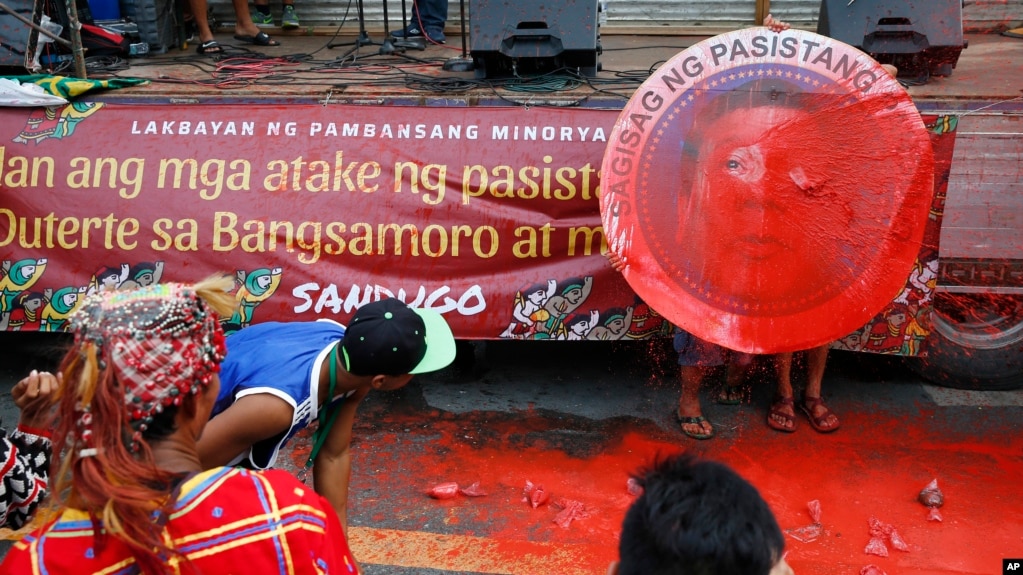
Indigenous people, including Muslims from the besiege city of Marawi, throw red paint at the mock seal of President Rodrigo Duterte to protest the continued siege and the martial law imposed by Duterte on the Mindanao region, Aug. 31, 2017, in Manila, Philippines.
Philippine President Rodrigo Duterte and military officials have promised to quickly defeat the Maute Group at its base, Marawi city. Analysts say fighting in the city on the embattled island of Mindanao could go on as long as that group or its sympathizers pose a terrorism threat, and there is no sign of the threat abating. Rebel violence has killed about 120,000 since the 1960s on Mindanao and curbed the largely impoverished island’s economic development.
“Sometimes it’s contradictory when they say there are only a few barangays (neighborhoods) that are controlled by the Maute Group, but still they cannot stop,” said Maria Ela Atienza, political science professor at University of the Philippines Diliman.
The government may have miscalculated the rebels’ reach when the battles began in May, she added. Their funding and support network could also extend to other cities and countries, making them harder to beat, scholars in the Philippines say. About 20 other rebel groups also operate on Mindanao to demand more autonomy from the Philippine government.
Officials predict final battles
Duterte on Tuesday “assured that the end of the siege is in sight” when he met in Manila with 35 displaced children from Marawi, according to a statement on his website. Duterte has also vowed to rebuild the city.
As of Monday Philippine media report, 603 terrorists had been killed along with 130 soldiers and police officers and 45 civilians. More than 183,000 people, most of Marawi’s original population, have been displaced.
On Sunday Defense Secretary Delfin Lorenzana was quoted in the Philippine Star online as saying troops were “preparing for final assault” in Marawi. The defense department was not available Friday for comment. Officials had said in June the Maute Group had been confined to just four neighborhoods of Marawi.
Life goes on
“A lot of people want the fighting to end and the reconstruction of Marawi to start,” said Antonio Ledesma, archbishop in the Mindanao city of Cagayan de Oro. But citizens of his city about a two-hour drive from Marawi expect little change for now.
“Actually a number of Muslim families have moved (from Marawi) over to Cagayan to Oro,” Ledesma said. “We’re also trying to provide aid to them, but life on Cagayan de Oro is as it is, not much problem with the situation there.”
Martial law declared for all of Mindanao has affected few people aside from vehicles stopped at road checkpoints, another Cagayan de Oro dweller said in July. Duterte declared martial law through Dec. 31 to make it easier for police and troops to make field decisions in Marawi.
“Sometimes it’s contradictory when they say there are only a few barangays (neighborhoods) that are controlled by the Maute Group, but still they cannot stop,” said Maria Ela Atienza, political science professor at University of the Philippines Diliman.
The government may have miscalculated the rebels’ reach when the battles began in May, she added. Their funding and support network could also extend to other cities and countries, making them harder to beat, scholars in the Philippines say. About 20 other rebel groups also operate on Mindanao to demand more autonomy from the Philippine government.
Officials predict final battles
Duterte on Tuesday “assured that the end of the siege is in sight” when he met in Manila with 35 displaced children from Marawi, according to a statement on his website. Duterte has also vowed to rebuild the city.
As of Monday Philippine media report, 603 terrorists had been killed along with 130 soldiers and police officers and 45 civilians. More than 183,000 people, most of Marawi’s original population, have been displaced.
On Sunday Defense Secretary Delfin Lorenzana was quoted in the Philippine Star online as saying troops were “preparing for final assault” in Marawi. The defense department was not available Friday for comment. Officials had said in June the Maute Group had been confined to just four neighborhoods of Marawi.
Life goes on
“A lot of people want the fighting to end and the reconstruction of Marawi to start,” said Antonio Ledesma, archbishop in the Mindanao city of Cagayan de Oro. But citizens of his city about a two-hour drive from Marawi expect little change for now.
“Actually a number of Muslim families have moved (from Marawi) over to Cagayan to Oro,” Ledesma said. “We’re also trying to provide aid to them, but life on Cagayan de Oro is as it is, not much problem with the situation there.”
Martial law declared for all of Mindanao has affected few people aside from vehicles stopped at road checkpoints, another Cagayan de Oro dweller said in July. Duterte declared martial law through Dec. 31 to make it easier for police and troops to make field decisions in Marawi.



No comments:
Post a Comment
Note: Only a member of this blog may post a comment.